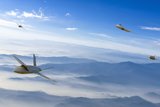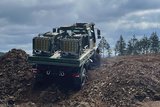Levelling up – how autonomous fire control tackles unmanned lethality head-on
Enjoy free access to this sponsored article, all content provided by OpenWorks
The recent Association of the United States Army (AUSA) annual meeting held in Washington DC was the backdrop for the launch of technologies that look set to take us further into a future characterised by machine-on-machine warfare.
Sikorsky displayed its new S-70UAS U-Hawk unmanned aircraft with 25% more cargo space, a multiple missile launch module and the ability to deploy swarms of strike drones, whilst Forterra, Raytheon and Oshkosh Defense displayed two autonomous DeepFires launcher prototypes.
The war in Ukraine has taught us just how mission-altering autonomous systems can be. UAS have pervaded the battlefield, often based upon cheap asymmetric technology, and threatened the freedom of manoeuvre and survivability of some of NATO’s most mature platforms. A US-supplied M1150 Assault Breacher Vehicle was reportedly lost to a drone attack, for example.
True to history, and with parallels to the IED threat in Iraq and Afghanistan, technology in the UAS and C-UAS space is developing rapidly to secure the operational longevity, tactical advantage and survivability of defence forces’ most precious assets – their people, machines and networks.
It is not surprising then, to see such formidable autonomous systems take the floor at an exhibition dedicated to the world’s most well-equipped army. We should be in no doubt that adversaries are watching and developing their own increasingly sophisticated autonomous solutions in response.
C-UAS and air defence need collaboration
With such high pace of technological change, the agility typical of small and medium enterprises is needed more than ever. Their speed, focus and freedom of choice allows them to innovate, integrate, test and trial in months, bringing novel solutions that outsmart current mission sets to market quickly.
While they may then face slow and layered procurement processes, deep collaboration with prime contractors helps to move those technologies from a standalone product to an integrated system in the hands of the end-user.

One such example is OpenWorks’ latest autonomous optics system, Vision Pace, which was displayed at AUSA with a General Dynamics 20mm revolver gun as part of a focus on short-range air defence (SHORAD).
Designed to enhance dynamic multiple threat engagement, Vision Pace offers microradian precision targeting within kinetic defeat chains, marking a step-change for layered air defence. The development is intended to provide capability for expeditionary force protection, GBAD, SHORAD and M-SHORAD across land and naval domains.
Vision Pace achieves its performance through low-friction direct-drive positioner and AI-powered stabilisation technology, leveraging OpenWorks’ proven AI classifiers and trackers. In under one second, Vision Pace can complete 180 degrees of resolution and automatically target a dynamic threat.
Building upon the widely deployed and modular approach of OpenWorks’ Vision Flex product family, Vision Pace is configurable to meet customer requirements thanks to the company's global technical support team.
This type of system architecture enables the integration of wide-ranging third-party primary detectors, sensors, classifiers and effectors along with OpenWorks’ proven EO and IR imagers. This meets the needs of a dynamic and rapidly evolving defence environment, whilst reducing the burden on human intervention.
At AUSA, Vision Pace was shown with Echodyne’s EchoShield MESA radar. The system fuses inputs to enhance accuracy and cue targeting when faced with multiple threats. Another recently launched configuration of Vision Pace comes with Thales’ TrueHunter Gimbal Sight sensor head.

This latter is proven across long-range multi-spectral observation, acquisition and target engagement in challenging environments, by day and night. The TrueHunter Gimbal Sight’s sensors include high-resolution daylight colour cameras, a cooled thermal imager (both with continuous zoom), SWIR sensor, laser rangefinder, laser pointer and a laser target designator.
Are fewer human operators needed in the loop?
As the battlespace enters its most futuristic era, we must meet autonomous lethality head on with autonomous countermeasures. In the UAS and C-UAS space, there is a proliferation of excellent solutions, but many still involve the watchful eye of an operator.
Whilst there is a very necessary human authorisation at the end of the kill chain, and debate rightly continues as to the extent of permissible automation in deploying an effector, intelligent detection, tracking and targeting means that there is reduced need for people "in the loop".
Increased stand-off and reduced reaction time is surely the best way to improve mission success and the survivability of our forces.
Find out more about OpenWorks’ intelligent solutions here.
More from Industry Spotlights
-
![The future is here: Sixth-gen air dominance]()
The future is here: Sixth-gen air dominance
How RTX is equipping the military airspace – for today’s fleet and tomorrow’s fight.
-
![De-Risking the Future: Manufacturing Certainty for Unmanned Systems]()
De-Risking the Future: Manufacturing Certainty for Unmanned Systems
How strategic manufacturing partnership solves the industrialisation triad — Scale, Compliance and Cost — for hyper-growth defence tech innovators.
-
![Battlefield mobility, made in the UK]()
Battlefield mobility, made in the UK
How does Britain ensure that we can preserve the lives of our soldiers and allies – now and in the future – with homegrown innovation and resilient domestic manufacturing? At Pearson Engineering, we are proud to be a central part of the answer to this increasingly important question.
-
![Strengthening Baltic defence capabilities]()
Strengthening Baltic defence capabilities
How Latvia is bolstering its territorial defences, industrial capacity and international cooperation with Dynamit Nobel Defence’s SKORPION2 Remote Mining System.
-
![Barco’s vision to trust: from past to future]()
Barco’s vision to trust: from past to future
Barco’s story is one of constant evolution enabling more immersive, reliable, and future-ready training experiences.
-
![How are next-generation ejection seats helping pilots when they need it most?]()
How are next-generation ejection seats helping pilots when they need it most?
The ACES 5 ejection seat from RTX’s Collins Aerospace introduces new, innovative and patented technologies to help save lives.



























